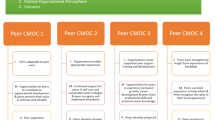Abstract
Peer work is a rapidly growing part of the mental health workforce, yet few studies explore the implementation of peer work in youth mental health. Qualitative focus groups were conducted with eight youth peer workers at the commencement of their employment, then at 3-months and 6-months after this time. Data were transcribed verbatim and analysed using thematic and trajectory analysis. The three main findings included: (1) there was a trajectory from fear to hope; (2) there was an improved understanding of benefits and role definition over time; and (3) there was an evolving concept of understanding shared experiences as a primary asset. Known barriers to implementing peer work are likely to occur in youth mental health settings as well. Ensuring that adequate training, change management and tailored support strategies are important to maximise the chances of successful youth peer work programs.
Similar content being viewed by others
References
Bailie, H. A., & Tickle, A. (2015). Effects of employment as a peer support worker on personal recovery: A review of qualitative evidence. Mental Health Review Journal,20(1), 48–64.
Braun, V., & Clarke, V. (2006). Using thematic analysis in psychology. Qualitative Research in Psychology,3(2), 77–101.
Carter, M. L. (2000). Social support systems as factors of academic persistence for African American, lower-income, first-year college students and high school graduates not attending college. Buffalo: State University of New York at Buffalo.
Chinman, M., Lucksted, A., Gresen, R., Davis, M., Losonczy, M., Sussner, B., et al. (2008). Early experiences of employing consumer-providers in the VA. Psychiatric Services,59(11), 1315–1321.
Davidson, L., Chinman, M., Sells, D., & Rowe, M. (2006). Peer support among adults with serious mental illness: A report from the field. Schizophrenia Bulletin,32(3), 443–450.
Delman, J., & Klodnick, V. V. (2017). Factors supporting the employment of young adult peer providers: Perspectives of peers and supervisors. Community Mental Health Journal,53, 811–822.
Fava, N., O'Bree, B., Randall, R., Kennedy, H., Olsen, J., Matenson, E., . . . Simmons, M. (2018). Youth Peer Work: Building a Strong and Supported Youth Peer Workforce (C. A. Ibe, Trans.). In J. Meagher, A. Stratford, F. Jackson, E. Jayakody, & T. Fong (Eds.), Peer Work in Australia: A New Future for Mental Health (h ed., Vol. a, pp. d). Sydney: RichmondPRA and Mind Australia
Gopalan, G., Lee, S. J., Harris, R., Acri, M. C., & Munson, M. R. (2017). Utilization of peers in services for youth with emotional and behavioral challenges: A scoping review. Journal of Adolescence,55, 88–115.
Grossoehme, D., & Lipstein, E. (2016). Analyzing longitudinal qualitative data: The application of trajectory and recurrent cross-sectional approaches. BMC Research Notes,9, 136. https://doi.org/10.1186/s13104-016-1954-1.
Holley, J., Gillard, S., & Gibson, S. (2015). Peer worker roles and risk in mental health services: A qualitative comparative case study. Community Mental Health Journal,51(4), 477–490.
King, A. J., & Simmons, M. B. (2018). A systematic review of the attributes and outcomes of peer work and guidelines for reporting studies of peer interventions. Psychiatric Services,69(9), 961–977. https://doi.org/10.1176/appi.ps.201700564.
MacNeil, C., & Mead, S. (2003). Discovering the fidelity standards of peer support in an ethnographic evaluation. Retrieved from http://www.mentalhealthpeers.com
McGorry, P. D., Tanti, C., Stokes, R., Hickie, I. B., Carnell, K., Littlefield, L. K., et al. (2007). headspace: Australia's National Youth Mental Health Foundation—Where young minds come first. The Medical Journal of Australia,187(7 Suppl), S68–S70.
Mead, S. (2003). Defining peer support. Intentional Peer Support: An Alternative Approach. Retrieved from http://www.intentionalpeersupport.org
Miyamoto, Y., & Sono, T. (2012). Lessons from peer support among individuals with mental health difficulties: A review of the literature. Clinical Practice & Epidemiology in Mental Health,8, 22–29. https://doi.org/10.2174/1745017901208010022.
Monson, K., & Thurley, M. (2011). Consumer participation in a youth mental health service. Early Intervention in Psychiatry,5(4), 381–388.
Mowbray, C. T., Moxley, D. P., & Collins, M. E. (1998). Consumers as mental health providers: First-person accounts of benefits and limitations. The Journal of Behavioral Health Services & Research,25(4), 397–411.
Pitt, V., Lowe, D., Hill, S., Prictor, M., Hetrick, S., Ryan, R., & Berends, L. (2013). Involving adults who use mental health services as providers of mental health services to others. Cochrane Database of Systematic Reviews (3).
Repper, J., & Carter, T. (2011). A review of the literature on peer support in mental health services. Journal of Mental Health,20(4), 392–411. https://doi.org/10.3109/09638237.2011.583947.
Simmons, M. B., Batchelor, S., Dimopoulos-Bick, T., & Howe, D. (2017). The choice project: Peer workers promoting shared decision making at a youth mental health service. Psychiatric Services, 68(8), 764–770.
Simmons, M. B., Coates, D., Batchelor, S., Dimopoulos-Bick, T., & Howe, D. (2018). The CHOICE pilot project: Challenges of implementing a combined peer work and shared decision-making programme in an early intervention service. Early Intervention in Psychiatry, 12(5), 964–971.
Simpson, A., Oster, C., & Muir-Cochrane, E. (2018). Liminality in the occupational identity of mental health peer support workers: A qualitative study. International Journal of Mental Health Nursing,27(2), 662–671. https://doi.org/10.1111/inm.12351.
Stratford, A. C., Halpin, M., Phillips, K., Skerritt, F., Beales, A., Cheng, V., et al. (2017). The growth of peer support: An international charter. Journal of Mental Health. https://doi.org/10.1080/09638237.2017.1340593.
Vandewalle, J., Debyser, B., Beeckman, D., Vandecasteele, T., Hecke, A. V., & Verhaeghe, S. (2016). Peer workers' perceptions and experiences of barriers to implementation of peer workers roles in mental health services: A literature review. International Journal of Nursing Studies,60, 234–250.
Funding
Funding was provided by Headspace National Office Service Innovation Project.
Author information
Authors and Affiliations
Corresponding author
Additional information
Publisher's Note
Springer Nature remains neutral with regard to jurisdictional claims in published maps and institutional affiliations.
Rights and permissions
About this article
Cite this article
Simmons, M.B., Grace, D., Fava, N.J. et al. The Experiences of Youth Mental Health Peer Workers over Time: A Qualitative Study with Longitudinal Analysis. Community Ment Health J 56, 906–914 (2020). https://doi.org/10.1007/s10597-020-00554-2
Received:
Accepted:
Published:
Issue Date:
DOI: https://doi.org/10.1007/s10597-020-00554-2




